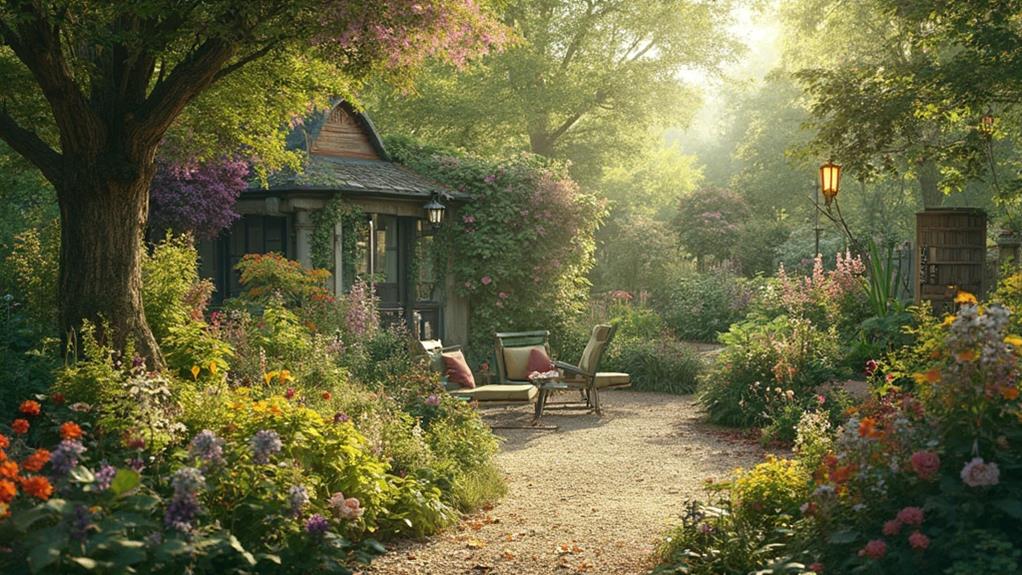Creating a butterfly garden transforms your outdoor space into a vibrant, eco-friendly haven for pollinators. Select native plants suited to your local climate, including nectar-rich flowers and host plants for larvae. Design diverse microclimates with sunny basking areas, sheltered spots, and shallow water features. Incorporate flat stones for sunbathing and dense shrubs for protection. Implement natural pest control methods like companion planting and beneficial predators. Ensure year-round attraction by choosing plants with varying bloom times. This pollinator-friendly renovation not only beautifies your landscape but also supports crucial ecosystem services. Discover how your garden can become a thriving sanctuary for butterflies and other beneficial insects.
Choosing the Right Plants
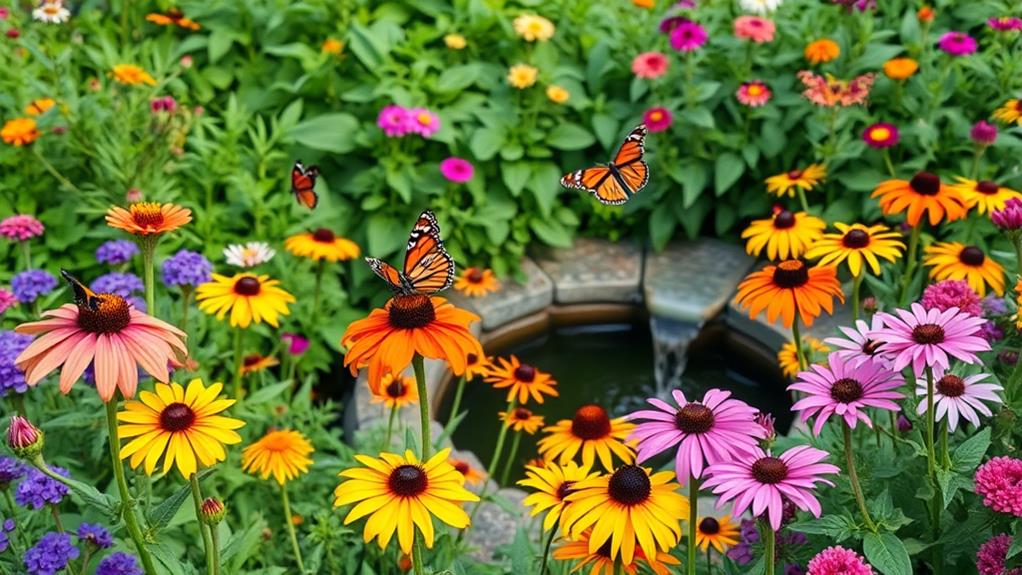
Plant selection is the cornerstone of creating a successful butterfly garden. Choose native plants that thrive in your local climate and soil conditions, as these are best adapted to support local butterfly species. Focus on including a variety of nectar-rich flowering plants that bloom at different times throughout the growing season to provide a continuous food source for adult butterflies.
Key plant varieties to consider include milkweed, butterfly bush, aster, coneflower, lantana, and zinnias. Milkweed is particularly crucial as it serves as the sole food source for monarch butterfly caterpillars. Incorporate both annuals and perennials to ensure diversity and year-round interest. Select plants with different heights, colors, and textures to create a visually appealing garden that attracts a wide range of butterfly species.
Don't forget to include host plants for butterfly larvae, such as fennel, dill, and parsley for swallowtail butterflies. Cluster plants of the same species together to create visible landing pads for butterflies and make it easier for them to locate food sources. Avoid using pesticides, as these can harm butterflies and other beneficial insects.
Creating Butterfly-Friendly Spaces
Designing a butterfly-friendly space goes beyond plant selection to encompass the overall layout and features of your garden. To create an inviting habitat, incorporate diverse microclimates that cater to different butterfly species' needs.
Include open, sunny areas for basking, as butterflies require warmth to regulate their body temperature and fly efficiently. Establish sheltered spots using shrubs, trees, or garden structures to protect butterflies from strong winds and predators.
Incorporate flat stones or other heat-absorbing surfaces where butterflies can rest and warm up. Provide shallow water sources, such as puddling areas or shallow dishes filled with sand and water, for butterflies to obtain essential minerals.
Arrange plants in clusters to create visual impact and make it easier for butterflies to locate nectar sources. Include both nectar plants for adult butterflies and host plants for caterpillars to ensure a complete life cycle habitat.
Avoid using pesticides, as they can harm butterflies and other beneficial insects. Instead, embrace natural pest control methods to maintain a healthy ecosystem. By thoughtfully designing your garden with these elements, you'll create an attractive and functional space that supports butterfly populations throughout the seasons.
Water Features for Pollinators
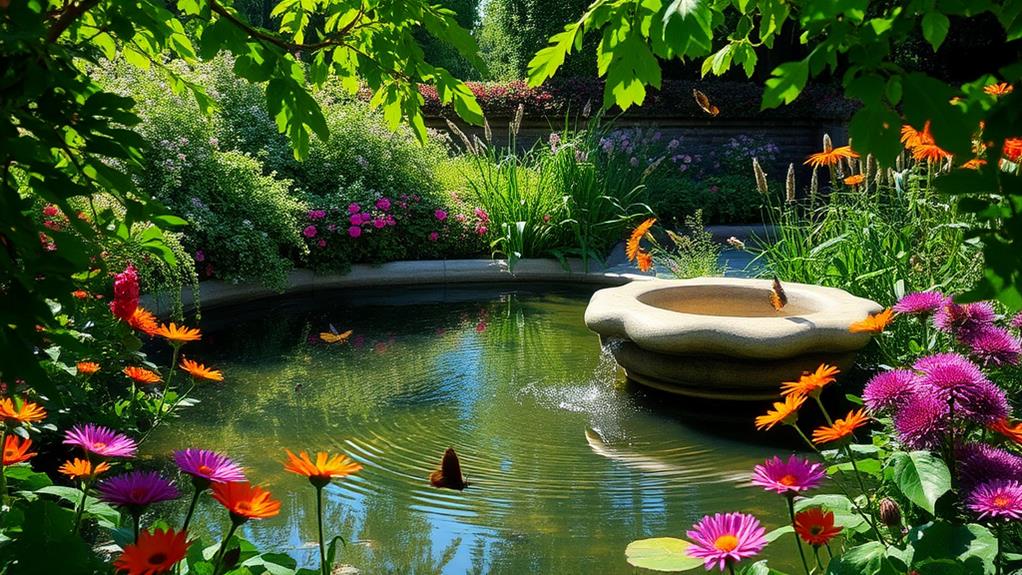
While often overlooked, water features play a crucial role in attracting and sustaining pollinators in a butterfly garden. These elements provide essential hydration and minerals for butterflies, bees, and other beneficial insects. To create an effective water source, consider implementing shallow, textured surfaces that allow pollinators to safely access water without drowning.
A simple butterfly puddling station can be created using a shallow dish filled with sand, pebbles, and water. This mimics natural mud puddles where butterflies gather to obtain minerals. For a more elaborate setup, consider installing a small fountain or birdbath with gently moving water. Ensure the water feature includes landing spots, such as partially submerged stones or floating cork, to provide safe resting areas for pollinators.
Maintain your water features by regularly cleaning and refilling them to prevent stagnation and mosquito breeding. Position these elements near flowering plants to create a complete habitat for pollinators. By incorporating thoughtfully designed water features, you'll not only enhance the aesthetic appeal of your butterfly garden but also support the vital needs of these essential creatures in your ecosystem.
Sunbathing and Shelter Areas
A well-designed butterfly garden incorporates both sunbathing spots and shelter areas to meet the diverse needs of pollinators. Butterflies require warmth to fly and regulate their body temperature, making sunny areas crucial for their activity. Create open spaces with flat rocks or concrete pavers where butterflies can bask in direct sunlight. Position these elements near nectar-rich flowers to encourage feeding.
Equally important are shelter areas that protect pollinators from harsh weather and predators. Incorporate dense shrubs, tall grasses, and small trees to provide refuge. Native plants like joe-pye weed, asters, and goldenrod offer both food and shelter. Install butterfly houses or create brush piles in quieter corners of the garden to offer additional protection.
Consider the garden's layout to ensure a balance of sun and shade throughout the day. South-facing slopes are ideal for maximizing sunlight exposure. Utilize vertical elements like trellises or pergolas to create microclimates within the garden, offering varying degrees of sun and shade. By providing both sunbathing and shelter areas, your garden will attract and sustain a diverse pollinator population, enhancing its ecological value and visual appeal.
Natural Pest Control Methods
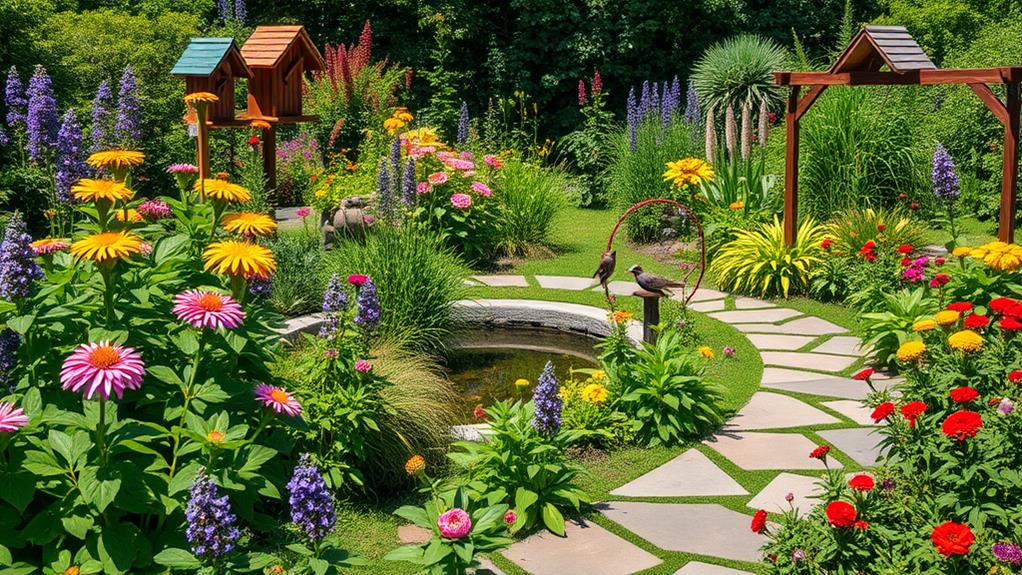
Natural pest control methods are essential for maintaining a healthy butterfly garden without resorting to harmful chemicals. These techniques work in harmony with the ecosystem, protecting beneficial insects while deterring destructive pests.
Companion planting is an effective strategy, utilizing plants like marigolds, nasturtiums, and herbs to repel common garden pests. Introducing beneficial predators, such as ladybugs, praying mantises, and lacewings, can help control aphid and caterpillar populations.
Physical barriers like row covers and netting protect vulnerable plants from flying insects and larger pests. Handpicking visible pests and regularly inspecting plants for signs of infestation are simple yet effective methods.
Encouraging biodiversity by planting a variety of native species creates a balanced ecosystem that naturally regulates pest populations. Neem oil and insecticidal soaps provide targeted control for persistent issues without harming pollinators.
Proper garden maintenance, including regular pruning and removal of debris, reduces hiding places for pests. By implementing these natural pest control methods, gardeners can create a thriving butterfly habitat while minimizing the need for chemical interventions, ensuring a safe environment for pollinators and other beneficial insects.
Year-Round Butterfly Attraction
Creating a butterfly garden that attracts these delicate pollinators year-round requires careful planning and selection of plants that bloom in different seasons. Start by incorporating early spring bloomers like crocus, daffodils, and pansies to provide nectar for emerging butterflies.
As spring progresses, introduce mid-season flowers such as lilacs, azaleas, and columbines.
For summer, plant a variety of butterfly favorites including milkweed, zinnias, coneflowers, and butterfly bush. Late summer to fall bloomers like asters, goldenrod, and sedum will sustain butterflies preparing for migration or overwintering. In warmer climates, winter-blooming plants such as camellias and winter jasmine can provide food sources during cooler months.
To ensure year-round attraction, include both nectar plants for adult butterflies and host plants for caterpillars. Provide shelter with shrubs, trees, and brush piles. Create sunny spots for basking and puddles for water and minerals. Avoid pesticides and opt for native plant species when possible. By offering a diverse range of plants and habitats, your garden can become a sanctuary for butterflies throughout the year.
Eco-Friendly Garden Maintenance
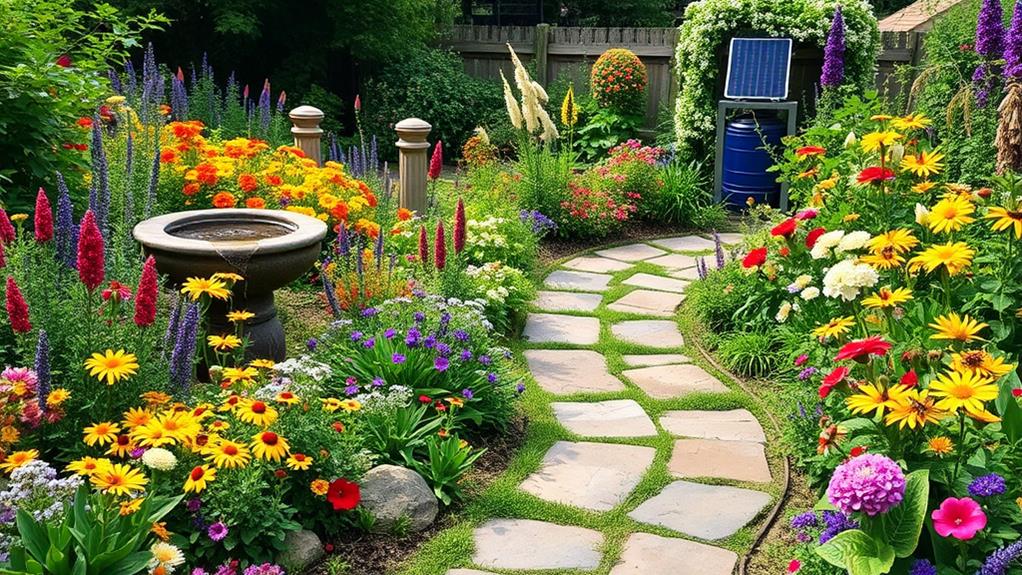
Maintaining a butterfly garden with eco-friendly practices is paramount for the health of both pollinators and the environment. Start by eliminating chemical pesticides and herbicides, which can harm butterflies and other beneficial insects. Instead, opt for natural pest control methods such as companion planting, manual removal of pests, and introducing beneficial predators like ladybugs.
Implement water conservation techniques by using mulch to retain soil moisture and installing rain barrels to collect rainwater for irrigation. Choose native plants adapted to your local climate, as they typically require less water and maintenance. Compost garden waste and kitchen scraps to create nutrient-rich soil amendments, reducing the need for synthetic fertilizers.
Practice sustainable pruning by selectively trimming plants to encourage growth and maintain shape, rather than excessive cutting. Leave some areas of your garden slightly wild, allowing native grasses and wildflowers to thrive, providing additional habitats for butterflies and other pollinators. Incorporate diversity in your plantings to support a wide range of butterfly species throughout their life cycles. By adopting these eco-friendly maintenance practices, you'll create a thriving, sustainable butterfly garden that benefits both pollinators and the broader ecosystem.
Frequently Asked Questions
How Long Does It Take to Establish a Thriving Butterfly Garden?
Establishing a thriving butterfly garden typically takes 2-3 years. The first year focuses on planting and initial growth, while subsequent years allow perennials to mature and attract more butterflies. Consistent care and maintenance are essential throughout this process.
Can Butterfly Gardens Attract Unwanted Insects or Pests?
Coincidentally, butterfly gardens can attract various insects, both beneficial and unwanted. While pollinators thrive, some pests may appear. However, the ecological balance created often naturally controls pest populations, minimizing potential issues without requiring extensive intervention from gardeners.
Are There Any Plants Toxic to Butterflies That Should Be Avoided?
While most plants are safe for butterflies, some can be toxic. Avoid planting milkweed species like tropical milkweed, which can harm monarchs. Also, steer clear of pesticide-treated plants and those with high alkaloid content, such as oleander.
How Much Space Is Needed to Create an Effective Butterfly Garden?
An effective butterfly garden can be created in relatively small spaces. Even a 100-square-foot area can attract butterflies. However, larger gardens of 400-500 square feet or more provide greater diversity and support for various butterfly species.
Do Butterfly Gardens Require Special Permits or Zoning Considerations?
As delicate as a butterfly's wings, zoning requirements for butterfly gardens are typically minimal. Most residential areas allow such gardens without special permits, but it's wise to check local regulations regarding plant height and water features.
Conclusion
A butterfly garden blooms as a vibrant tapestry of life, weaving together the delicate threads of nature's grand design. By cultivating pollinator-friendly spaces, gardeners become stewards of biodiversity, nurturing a sanctuary where winged jewels dance from petal to petal. This living canvas, painted with carefully chosen plants and thoughtful features, transforms outdoor spaces into havens of beauty and ecological importance. As seasons ebb and flow, the butterfly garden stands as a testament to the enduring harmony between human ingenuity and the natural world.
